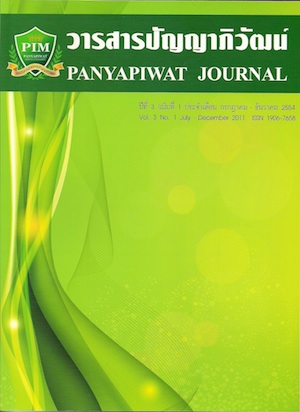ความรู้เรื่องตลาดการค้าคาร์บอนเครดิต
Main Article Content
บทคัดย่อ
บทคัดย่อ
ปัญหาโลกร้อนหรือปัญหาการเปลี่ยนแปลงทางสภาพภูมิอากาศนับว่าเป็นประเด็นที่ทั่วโลกตื่นตัว และให้ความสนใจเป็นอย่างมาก โดยประเทศต่างๆได้ร่วมมือกันเพื่อที่จะลดปริมาณก๊าซเรือนกระจกภายใต้พิธีสารเกียวโต จากจุดนี้เองจึงเป็นที่มาของการซื้อขายคาร์บอนเครดิตผ่านตลาดคาร์บอน ทั้งตลาดคาร์บอนแบบทางการและตลาดคาร์บอนแบบสมัครใจ ผ่านกลไกการพัฒนาที่สะอาด (CDM) กลไกการพัฒนาร่วมกัน (JI) และกลไกการซื้อขายก๊าซเรือนกระจกระหว่างประเทศ (ET) ทั้งนี้ประเทศไทยเป็นประเทศหนึ่งที่เข้าร่วมการลดปริมาณก๊าซเรือนกระจกแบบสมัครใจ ผ่านโครงการการพัฒนากลไกที่สะอาด และได้มีการพัฒนา Certified Emission Reductions (CERs) ที่สามารถใช้ในการค้าขายในตลาดคาร์บอน เนื่องจากเชื่อกันว่าในอนาคตตลาดคาร์บอนจะมีการ ขยายใหญ่ขึ้นโดยเฉพาะตลาดคาร์บอนแบบสมัครใจ และคาร์บอนเครดิตจะเปรียบเสมือนสินค้า ส่งออกที่สามารถนำรายได้ให้กับประเทศไทย รัฐบาลไทยควรจะให้การสนับสนุนผู้ประกอบการ ในประเทศให้มีความพร้อมทั้งทางด้านเทคโนโลยี และทางด้านการเงิน เพื่อให้การพัฒนาเศรษฐกิจ ของประเทศเป็นไปอย่างมั่นคงและยั่งยืน
คำสำคัญ: ตลาดคาร์บอน คาร์บอนเครดิต กลไกการพัฒนาที่สะอาด การพัฒนาที่ยั่งยืน
Abstract
Certainly global warming and climate change issues have received tremendous attention this decade. Hence, most countries commit themselves to a reduction of greenhouse gases under the Kyoto Protocol. These emission limits initiate the concept of carbon trading through both regulated carbon market and voluntary carbon market. Three mechanism that enable countries to achieve greenhouse gas reduction credit or carbon credit consist of Clean Development Mechanism (CDM), Joint Implementation (JI) and Emission Trading (ET). Although Thailand has no obligation to reduce greenhouse gas by the Kyoto Protocol, Thailand has adopted Clean Development Mechanism in order to reduce greenhouse gas voluntarily and receive Certified Emission Reductions (CERs). CERs are used for trading purpose in carbon markets, which have been increasing in size especially in voluntary carbon market. Since CERs can bring income to the country through emission trading, Thai government should support both technologies and finance on CDM projects in order to encourage clean technology and sustainable growth in Thailand.
Keywords: Carbon Market, Carbon Credit, Clean Development Mechanism, Sustainable Growth
Article Details
“ข้าพเจ้าและผู้เขียนร่วม (ถ้ามี) ขอรับรองว่า บทความที่เสนอมานี้ยังไม่เคยได้รับการตีพิมพ์และไม่ได้อยู่ระหว่างกระบวนการพิจารณาลงตีพิมพ์ในวารสารหรือแหล่งเผยแพร่อื่นใด ข้าพเจ้าและผู้เขียนร่วมยอมรับหลักเกณฑ์การพิจารณาต้นฉบับ ทั้งยินยอมให้กองบรรณาธิการมีสิทธิ์พิจารณาและตรวจแก้ต้นฉบับได้ตามที่เห็นสมควร พร้อมนี้ขอมอบลิขสิทธิ์บทความที่ได้รับการตีพิมพ์ให้แก่สถาบันการจัดการปัญญาภิวัฒน์หากมีการฟ้องร้องเรื่องการละเมิดลิขสิทธิ์เกี่ยวกับภาพ กราฟ ข้อความส่วนใดส่วนหนึ่งและ/หรือข้อคิดเห็นที่ปรากฏในบทความข้าพเจ้าและผู้เขียนร่วมยินยอมรับผิดชอบแต่เพียงฝ่ายเดียว”
เอกสารอ้างอิง
Bayon, R., Hawn, A., & Hamilton, K. (2007). Voluntary carbon markets: An international business guide to what they are and how they work. London: Earthscan.
Capoor, K. and Ambrosi, P. (2009). State and trends of the carbon market 2009. Washington DC: World Bank.
Mercheker, D. (2009). The business of carbon credit trading for forest landowners. Retrieved January 10, 2011, from W217 The Business of Carbon Credit Trading for Forest Landowners, The University of Tennessee Agricultural Extension Service Website: http://trace.tennessee .edu/utk_agexfores/42/
Oberthur, S. & Ott, H. E. (1999). The Kyoto Protocol International Climate Policy for the 21st Century. Berlin: Springer.
Passey, R., MacGill, I., Nolles, K., & Outhred, H. (2005). The NSW Greenhouse Gas Abatement Scheme: An analysis of the NGAC Registry for the 2003 Compliance Period. Discussion Paper DP_050405, Centre for Energy and Environmental Markets, University of NSW.
Soltau, F. (2009). Fairness in international climate change law and policy. New York: Cambridge University Press.
Steven, R. (2000). Economic analysis of global climate change policy: A primer. Working Paper Series rwp00-00.
United Nations Framework Convention on Climate Change. (2006). Report of the Conference of the Parties serving as the meeting of the Parties to the Kyoto Protocol on its first session, held at Montreal from 28 November to 10 December 2005. Part One. United Nations Office, Geneva.
United Nations Framework Convention on Climate Change. (2010). Report of the Conference of the Parties on Its Fifteenth Session. Retrieved January 10, 2011, from United Nations Website: http://unfccc.int/resource /docs/2009/cop15/eng/11a01.pd


